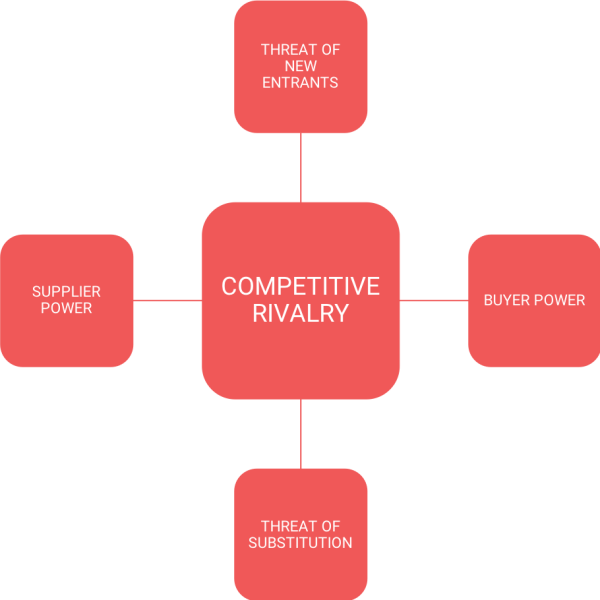Porter’s Five Forces is an established framework to analyze a market[1]. A market is defined as a specific industry that sells similar products. Porter’s analysis is used to assess market attractiveness both for new entrants and existing companies [2]. In general, the stronger the five forces are, the less attractive is the industry. During increased competition, companies need more than usual resources to survive, which ultimately leads to less attractiveness. The following schematic shows the elements of Porter’s five forces. To analyze an industry, you need data about five forces and then assess their potential power in the market.

Porter’s Five Forces
Negotiating Power of Suppliers
The negotiating power of suppliers is defined as the amount of leverage the suppliers have for selling their products. A high negotiating power often leads to higher prices or lower quality, thereby lowering the potential margin of the industry. Following are some signs that a supplier has a high negotiating power:
- Relatively lower threat for a supplier to get acquired by another company
- High switching costs for a buyer to change suppliers
- Availability of only few suppliers (or high concentration of few suppliers)
- Highly specialized supplies, no substitutes for the supplied good
Negotiating Power of Buyers
This concept is analogous to the supplier power discussed above. If buyers have a lot of negotiating power, it generally implies strong leverage to enforce low prices. Following are some signs that a buyer has a high negotiating power:
- High danger of backwards integration or an ability of buyers to produce the product easily
- Low switching costs
- High concentration of customers or a only a few customers relative to number of suppliers
- Large volumes of products bought by a single buyer
- Better or easy alternatives for buyers to switch
Threat of New Market Entrants
The lower the barriers for market entry, the easier it is for new competitors to enter the market thus leading to higher competition and thereby increasing the risk of price wars and a lower margin. Hence, an attractive industry usually has high entry barriers. It is hard to enter an attractive industry, but once a company is able to enter, it is in a good shape. The market entry barriers are:
- Economies of scale because new entrants sell lower volumes and face higher costs per unit
- High learning effects because established players’ experience leads to better contracts, operations, customer relationships
- High capital intensity and investment costs
- Governmental regulations
- Competitive environment
- Low accessibility to suppliers and customers
Threat of Substitute Products
Substitute products are alternatives to products that are obviously different but fulfill the same customer needs. The more substitute products, the easier it is for the customers to switch, thereby leading to a more competitive environment. Following are a few indicators for a high threat of substitute products:
- Current products are old and at the end of product life cycle
- High comparability of substitute products and high visibility as substitute
- Similar prices
Rivalry within Industry
The level of industry rivalry is influenced by the remaining four forces of Porter but is also subject to other causes. A high rivalry appears either as competition in terms of price or in terms of quality. The signs of high rivalry are:
- Very similar products
- High number of market players competing against each other
- Low or shrinking growth as competitors fight over a saturated market
- High barriers of exit due to high sunk costs
References




